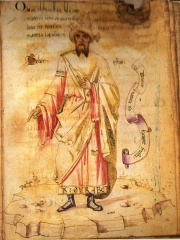

The Most Famous
CHEMISTS from Iran
This page contains a list of the greatest Iranian Chemists. The pantheon dataset contains 602 Chemists, 2 of which were born in Iran. This makes Iran the birth place of the 33rd most number of Chemists behind Australia, and South Africa.
Top 2
The following people are considered by Pantheon to be the most legendary Iranian Chemists of all time. This list of famous Iranian Chemists is sorted by HPI (Historical Popularity Index), a metric that aggregates information on a biography's online popularity.

1. Jabir ibn Hayyan (721 - 815)
With an HPI of 82.30, Jabir ibn Hayyan is the most famous Iranian Chemist. His biography has been translated into 89 different languages on wikipedia.
Abū Mūsā Jābir ibn Ḥayyān (Arabic: أَبو موسى جابِر بِن حَيّان, variously called al-Ṣūfī, al-Azdī, al-Kūfī, or al-Ṭūsī), died c. 806−816, is the purported author of a large number of works in Arabic, often called the Jabirian corpus. The c. 215 treatises that survive today mainly deal with alchemy and chemistry, magic, and Shi'ite religious philosophy. However, the original scope of the corpus was vast, covering a wide range of topics ranging from cosmology, astronomy and astrology, over medicine, pharmacology, zoology and botany, to metaphysics, logic, and grammar. The works attributed to Jabir, which are tentatively dated to c. 850 – c. 950, contain the oldest known systematic classification of chemical substances, and the oldest known instructions for deriving an inorganic compound (sal ammoniac or ammonium chloride) from organic substances (such as plants, blood, and hair) by chemical means. His works also contain one of the earliest known versions of the sulfur-mercury theory of metals, a mineralogical theory that would remain dominant until the 18th century. A significant part of Jabir's writings deal with a philosophical theory known as "the science of the balance" (Arabic: ʿilm al-mīzān), which was aimed at reducing all phenomena (including material substances and their elements) to a system of measures and quantitative proportions. The Jabirian works also contain some of the earliest preserved Shi'ite imamological doctrines, which Jabir presented as deriving from his purported master, the Shi'ite Imam Jaʿfar al-Ṣādiq (died 765). As early as the 10th century, the identity and exact corpus of works of Jabir was in dispute in Islamic scholarly circles. The authorship of all these works by a single figure, and even the existence of a historical Jabir, are also doubted by modern scholars. Instead, Jabir ibn Hayyan is generally thought to have been a pseudonym used by an anonymous school of Shi'ite alchemists writing in the late 9th and early 10th centuries. Some Arabic Jabirian works (e.g., The Great Book of Mercy, and The Book of Seventy) were translated into Latin under the Latinized name Geber, and in 13th-century Europe an anonymous writer, usually referred to as pseudo-Geber, started to produce alchemical and metallurgical writings under this name.

2. Shahram Amiri (1978 - 2016)
With an HPI of 42.36, Shahram Amiri is the 2nd most famous Iranian Chemist. His biography has been translated into 16 different languages.
Shahram Amiri (Persian: شهرام امیری Šahrâm Amiri; 8 November 1978 – 3 August 2016) was an Iranian nuclear scientist who disappeared from Iran during 2009–2010 under disputed circumstances, and was executed by the Iranian government in August 2016. In the spring of 2009, he disappeared while apparently on a pilgrimage to Mecca, Saudi Arabia. On 27 September 2009, Tehran Bureau noted conflicting information regarding the date of his disappearance: the Tehran Times claimed that Amiri disappeared on 31 May, but Press TV claimed he disappeared in June. In the same announcement by Tehran Bureau, it was claimed that Amiri conducted research on particle physics at the Malek-Ashtar University of Technology in Tehran and that this institution was controlled by the Islamic Revolutionary Guard Corp. About a year after his disappearance, two videos appeared, each purporting to be declarations by Amiri, but with contradictory stories. One showed him (or the person claiming to be him), stating that he had been kidnapped and tortured by Saudis and Americans; the other that he was in America of his own free will. In July 2010, Shahram Amiri reappeared in Washington, D.C. at the Iran interests section of the Embassy of Pakistan, seeking help to return to Tehran. Shortly thereafter he spoke at a press conference in Tehran, telling journalists he had been kidnapped, tortured and bribed to cooperate with the CIA, but had refused. In 2009, the Iranian government accused the US government of kidnapping him. Later, the Iranian state media reported that he was working as a double agent for Iranian intelligence. After his return to Iran, American sources confirmed he had arrived in, or was taken to, the United States with the help of the CIA, but insisted he had not been taken or kept against his will. ABC News and the newspaper Haaretz suggested Amiri "wanted to seek asylum abroad." According to a 2011 report by NPR news, he "was believed to be an agent-in-place for the CIA", who decided "he wanted out of Iran", but once in the US "got cold feet" and "made his way back to Iran". Nevertheless, he was sentenced to ten years in prison after returning. Despite this sentence, he was reported as executed in August 2016, and his body was returned to his family with rope marks around his neck.
People
Pantheon has 2 people classified as Iranian chemists born between 721 and 1978. Of these 2, none of them are still alive today. The most famous deceased Iranian chemists include Jabir ibn Hayyan, and Shahram Amiri.

